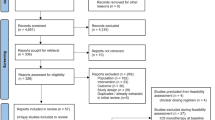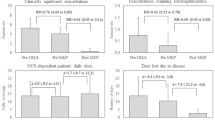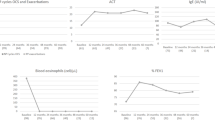Abstract
Aims:
To investigate the magnitude of change in morning peak expiratory flow (PEF), asthma symptoms, and rescue β2-agonist use, when the aim of treatment is to achieve guideline-defined control.
Methods:
This was a protocol-defined analysis of data from the previously-reported one-year, stratified, randomised, double-blind, parallel-group GOAL study comparing the use of salmeterol/fluticasone propionate with fluticasone propionate alone in achieving guideline-defined control; this analysis assessed the magnitude of change in single specific endpoints which were amalgamated into the composite measure of control used in the primary GOAL analysis.
Results:
Across all strata, improvements were seen for each outcome at 52 weeks as compared to baseline: mean morning PEF, 58.2 l/min (salmeterol/fluticasone propionate) versus 33.9 l/min (fluticasone propionate alone); symptom scores, −1.0 versus −0.8; symptom-free days, 72.5% versus 54.5%; mean of zero night awakenings, 31% versus 22%; rescue-free days, 87.3 versus 74.7; annualised rate of severe exacerbations, 0.02 versus 0.03; p<0.001 for all treatment differences.
Conclusions:
Aiming for guideline-defined control resulted in sustained, clinically relevant improvements in a range of individual asthma outcomes. Improvements were greatest with salmeterol/fluticasone propionate versus fluticasone propionate alone.
Similar content being viewed by others
Article PDF
Author information
Authors and Affiliations
Consortia
Corresponding author
Ethics declarations
Competing interests
AAW has received education, research and travel grants, and remuneration for lectures, consultancy and advisory boards, from GlaxoSmithKline (GSK). He has also received remuneration for these activities from Chiesi Pharmaceuticals, Novartis, Oriel Therapeutics, and Schering-Plough.
AB — no conflicts of interest declared
WB — no conflicts of interest declared
MRG is an employee of GSK. He co-ordinated the study and assisted with the reporting of the study results
JB received honoraria for his involvement in the GOAL study
EDB has received remuneration from GSK for lectures, membership of advisory boards and consultancy.
He has also received remuneration for these activities from AstraZeneca, Hoffman-la-Roche, ALTANA, Boehringer Ingelheim, and Pfizer
Rights and permissions
About this article
Cite this article
Woodcock, A., Bagdonas, A., Boonsawat, W. et al. Improvement in asthma endpoints when aiming for total control: salmeterol/fluticasone propionate versus fluticasone propionate alone. Prim Care Respir J 16, 155–161 (2007). https://doi.org/10.3132/pcrj.2007.00043
Received:
Accepted:
Published:
Issue date:
DOI: https://doi.org/10.3132/pcrj.2007.00043



